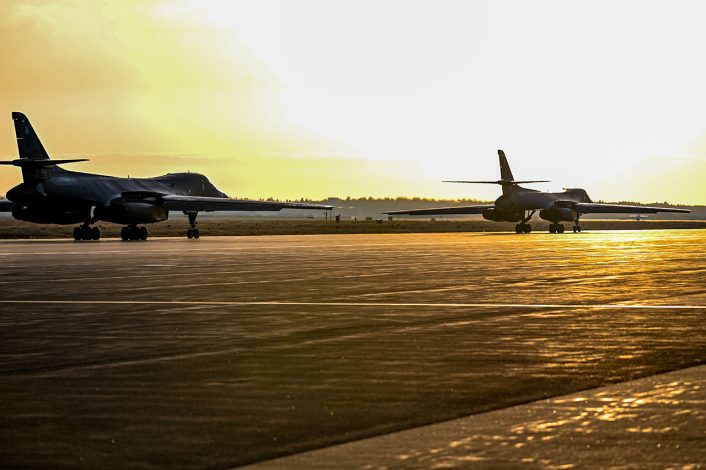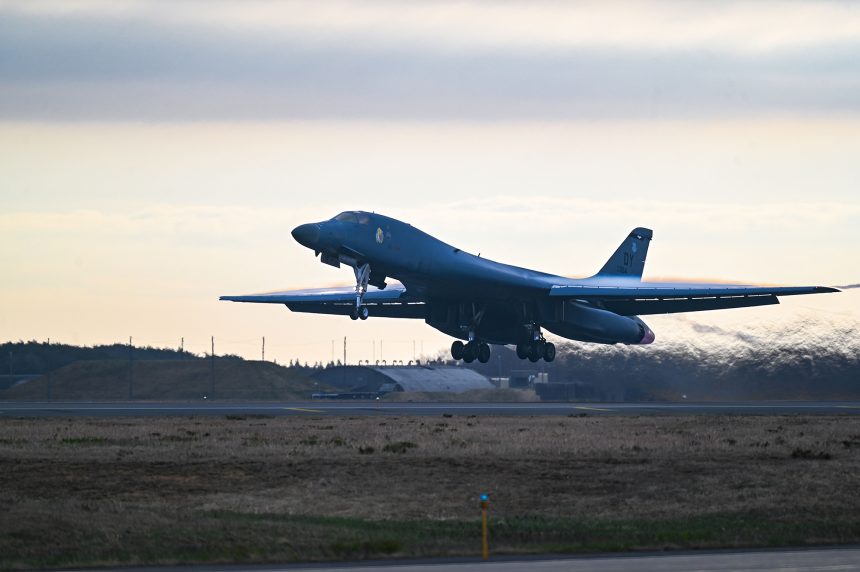Misawa Airport, currently hosting B-1B Lancers on a Bomber Task Force deployment, was forced to close for 90 minutes following an emergency landing.
Officials from Misawa city’s administration, as well as from the wider Aomori Prefecture, have called on leadership at Misawa Air Base and the government to institute new measures to prevent such incidents from affecting civilian air traffic in the future.
Misawa Airport shares its single runway with the co-located Misawa Air Base, hosting a variety of military aircraft from both Japan and the United States. The regional airport was forced to close for approximately 90 minutes when a B-1B Lancer landed following an in-flight emergency on Apr. 29, 2025.
Under the guidance of existing procedures, the aircraft was held on the runway after landing to allow for an inspection by ground crews. The resulting closure of the runway caused an inbound flight from Tokyo Haneda Airport to divert back to Tokyo – this diversion as well as the cancellation of the return leg from Misawa disrupted the travel plans of around 200 passengers.
Local concerns were exacerbated given the previous submission of a safety request on Apr. 18, after the arrival of the B-1s on deployment, asking for measures to be taken to ensure Misawa Airport’s ability to continue providing a service uninterrupted by increased military movements.
🇺🇸✈️🇯🇵 B-1B Lancers arrived at Misawa AB for #BTF25_2—reinforcing regional security & training on the ground and in the air alongside @JASDF_PAO_ENG.
Airmen of the 9th EBS stand ready to deliver agile combat #AirPower anytime, anywhere.#PACAF #B1B #StrongerTogether #ReadyAF pic.twitter.com/VQdzoyMFBk
— PACAF (@PACAF) April 23, 2025
At many civilian operated single-runway airports, clearing an aircraft from the runway following an emergency landing is often, if safe to do so, completed as soon as possible. Providing emergency cover can still be offered at a sufficient level, this allows airport operations to continue and drastically reduces any disruption. Inspections can then be carried out on the taxiway before the aircraft is allowed to taxi, or be towed, to a gate, stand, or maintenance area.
As reported by Stars and Stripes, Aomori Prefecture officials stated: “We believe that the incident causes anxiety to the people of the prefecture, where Misawa Air Base is located,” further adding “We deeply regret that it occurred despite our request for civil stability and safety measures made on April 18.”

The Bomber Task Force 25-2 deployment marks the first time U.S. strategic bombers have been forward deployed to Japan for more than a few days in several decades. Four B-1B Lancers in total have been noted taking part in the deployment, which Captain Leeroy Stark from the Misawa-based 35th Fighter Wing says supports “the larger Indo-Pacific strategy to uphold a free and open Indo-Pacific”.
While the deployment, at a time of increased global instability and expanding Chinese military activity in the region, is publicly welcomed by the Japanese government, public sentiment regarding deployed U.S. forces has long been strained.
Misconduct by drunken U.S. service members have led to crackdowns on off-base activities enforced by military chiefs, while only in March a U.S. Marine from Marine Corps Air Station Iwakuni was arrested by Japanese police under allegations of trespassing, drunk driving, and theft. Another incident, involving a Marine stationed on Okinawa charged with rape, became public in late April.
U.S. forces in Japan said the first meeting of a new forum between U.S. forces and local officials will take place on May 9 to address concerns following sexual assaults by U.S. soldiers in Okinawa Prefecture. https://t.co/Gc8Unia2kw
— The Japan Times (@japantimes) April 30, 2025
In January, a survey conducted by Kyodo News revealed that as many as 70% of Japan’s 47 prefectures would prefer that the pact governing U.S. forces stationed in the country be renegotiated. Okinawa Prefecture, which is home to Kadena Air Base, joined Kanagawa (home of the Yokosuka naval base) and Shimane in saying their residents’ lives were “frequently affected” by U.S. military activities.
Despite the troubles, the strong alliance with Japan on an intergovernmental level has continued and the U.S. military contingent in Japan – U.S. Forces Japan – is in the process of expanding its role and becoming a joint force headquarters.









